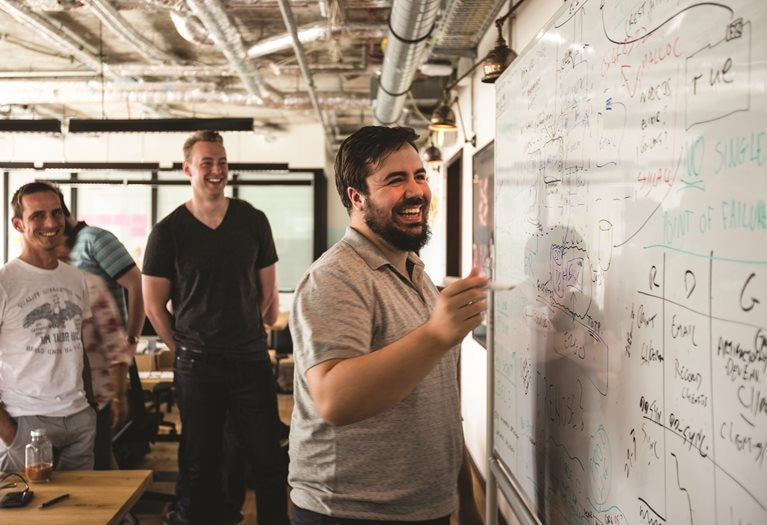“If you’re not reinventing your business every five years, you risk losing relevance,” says Neal Larkin, a design associate partner in McKinsey. “For businesses to stay competitive today, they’ve got to be thinking that way.”
For leaders thinking about building a new digital business, Leap turns ambition into action.
“With technology moving so fast, there’s no time for inaction. We’re about doing,” explains Ari Libarikian, a McKinsey senior partner and a global leader for Leap. “Many companies spend a lot of time thinking and talking about their digital future. Leap is all about getting them there quickly by building something new based on the parent company’s strengths.”
Leap teams feature a mix of business-building experts, including specialists in analytics, design, and tech. Most of these colleagues have launched their own successful businesses before joining our firm and understand the capabilities a business needs to survive and thrive.
“From day one, we build for our work to endure,” explains Ari. “The goal is to build and train a new muscle for our clients, who will then sustain and further strengthen it long after we are gone.”
To date, Leap teams have led over 200 business builds, many in less than 12 months. Ralf Dreischmeier, a McKinsey senior partner and a global leader for Leap, explains that Leap’s way of working plays a major role in this success. “We co-locate with our clients and use an agile model to move quickly, while bringing the benefits of a start-up to a corporate environment.”
Here are three stories that illustrate some of Leap’s most exciting work.
Streaming sports in Asia-Pacific
“Think video on demand for sports but cooler,” says Clayton O’Toole, a McKinsey partner in our Strategy & Corporate Finance Practice. That’s how he describes the over the top service he and his team built with a multinational media conglomerate that launched earlier this year in Asia.
According to Clayton, only about 25 percent of consumers in a national market were paying for sports content, while over 50 percent considered themselves passionate sports fans. So, Leap worked with our client to seize that opportunity, building an entirely separate streaming business that leverages all of the parent company’s sports rights.
The Leap team worked closely with the media company across content selection, pricing and packaging, tech-vendor selection, legal requirements, and talent sourcing. Extensive customer research through deep structured interviews meant the new product’s prototypes and wireframes reflected what customers really wanted.

Get to know Leap
“The way you engage with sports should be very different from how you watch movies and TV,” explains Eleni Watts, a McKinsey associate who spent 15 months as chief of staff to the company’s CEO. “With sports, you have the ability to deliver unique and interactive features with a greater degree of personalization.”
Testing and iterating with customers helped the team fine tune service features like in-game catch-up highlights and a ‘no spoilers’ mode.
It’s all added up to a winning game plan. The streaming service is on an exciting growth trajectory so far, having already reached 15 percent of the client’s subscriber base in just six months since launch.
Digital banking in North America
For a 175-year-old financial institution, becoming the first agile and design-led bank in a regional market meant Leap had the chance to create entirely new customer experiences. Call center frustration gave way to online banking satisfaction, 10-day lending approvals were cut to three minutes, and opening an account became a 30-minute appointment instead of a three-to-five-day ordeal.
“We were working in an area where design thinking and agile practices had yet to be used in any industry,” says Neal. “So embedding this way of working was an exciting challenge.”

Over the course of 12 weeks, the Leap team partnered with McKinsey’s Digital Academy to build and pilot a capability-learning program that would turn employees into design thinkers to serve customers in new ways through new digital channels.
By 24 weeks, the team had shadowed and coached over 200 employees and established 13 agile teams. They also worked closely with HR to create and source talent for new roles like user experience designers, engineers, and data scientists.
“We were focused on making design part of the culture,” says Neal. “This means putting the customer at the center of the problem you’re trying to solve, understanding how to do customer research and map out user journeys, and having the technology in place to build minimum viable products.”
The digital transformation helped the bank surpass $10 billion in profit. Having now captured a 40 percent market share, the bank is poised to solidify a number one position in the market.
Digital lending in Europe
For years, the lending market was one of the main sources of revenue for a European bank, but recently that space has become increasingly competitive. So, the bank turned to Leap for help.
We built them what McKinsey senior partner Mieke Van Oostende calls a “speed boat,” a digital-lending business for small and medium-sized enterprises. “We had a ton of freedom to move really quickly and test and play in this project,” says Mieke.
Ideation sessions helped shape the product, a clickable prototype brought it to life, and customer tests guided development. “We defined a cadence of work built on agile,” adds Fernando Figueiredo, a McKinsey associate partner. “This allowed us to move fast and keep improving the product.”
We weren’t working as traditional consultants. Our roles were more like entrepreneurs bringing varied skillsets together.
Mohcine Ouass McKinsey associate partner
The team worked as one unit in one location over two-week sprints. Daily check-ins ensured close collaboration between disciplines, particularly tech and design. “We weren’t working as traditional consultants,” says Mohcine Ouass, an associate partner. “Our roles were more like entrepreneurs bringing varied skillsets together.”
After six months, the digital lending business was live; it had customers and 40 full-time employees. With its 15-minute loan decisions and cash delivery in less than a day, the digital lender has earned the highest net-promoter score in the market after just a year and a half.